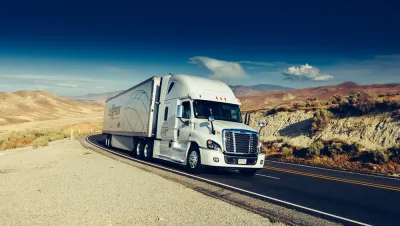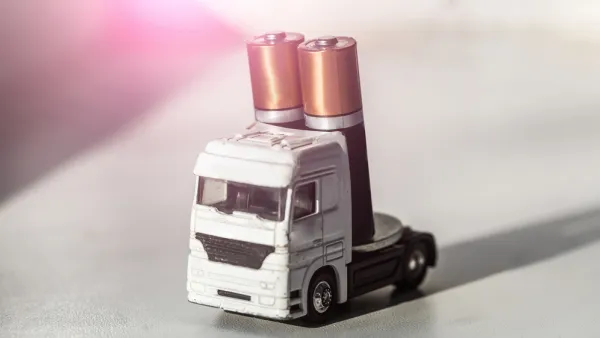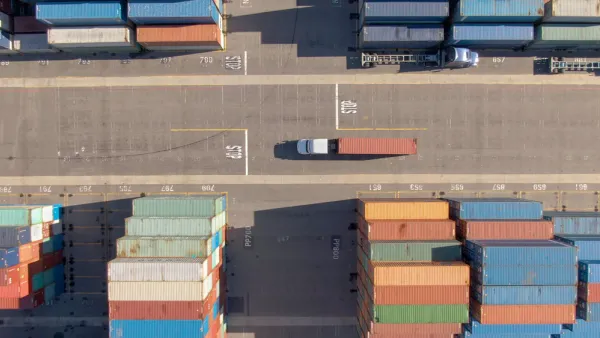Five days after approving a landmark rule to phase out the sale of new light duty vehicles powered by internal combustion engines, the California Air Resource Board released a rule that applies to the sale of new medium and heavy duty ICE vehicles.

Just over two years ago, California adopted the world’s first zero-emission commercial truck requirement. And on August 31, less than a week after having approved a landmark ban on the sale of light duty vehicles powered by internal combustion engines, the California Air Resources Board released a draft regulation that intends to do the same for the sale of medium and heavy duty vehicles, mostly powered by diesel engines believed to be responsible for about 70 percent of California's estimated known cancer risk attributable to toxic air contaminants.
Known as the Advanced Clean Fleets regulation, its goal is to “achieve a zero-emission truck and bus California fleet by 2045 everywhere feasible and significantly earlier for certain market segments such as last mile delivery and drayage applications,” according to the Air Resources Board.
The proposed regulation, summarized here, is described in a 296-page staff report [pdf] released August 30. A public hearing is scheduled to formally adopt the rule on Oct. 27. Written comments from the public are being accepted through Oct. 17.
Goes further than ICE passenger vehicle sales ban
Unlike the sales ban approved last month for internal combustion light duty vehicles which doesn't apply to the operation of gas and diesel-powered cars and light trucks, “large trucking companies would have to gradually convert their existing fleets to zero-emission vehicles, buying more over time until all are zero emissions by 2042,” reports Nadia Lopez who covers environmental policy issues for CalMatters in the source article.
Drayage trucks — used largely to transport cargo from ports and railways — would have the strictest timeline. New models would be zero-emission in 2024, while diesel and gas drayage trucks must retire after 18 years to guarantee that they meet a zero-emission requirement by 2035.
As noted above, the regulation would take effect in just two years for some categories of trucks and truck fleets, adds Lopez.
In addition, half of all new trucks purchased by state and local governments would be zero-emission in 2024, increasing to 100% by 2027. Some exemptions are allowed, if there is a lack of available models. Counties with small populations, including Inyo, Butte, Mendocino and Tuolumne, would be exempt until 2027.
The regulation appeared to be well-received by truck manufacturers Tesla, Volvo and Nikola as noted in the CalMatters piece.
Challenges ahead
Electrifying long-haul trucking will be a formidable task. “Long-haul diesel trucks can operate up to 1,000 miles before needing to refill the tank, which takes 10 to 15 minutes to fill up,” writes Lopez. “But electric models have to be charged often because they have 'significantly shorter range' and they take hours to charge.”
“The charging infrastructure that is necessary to support these trucks is basically non-existent today. Even the fastest available chargers right now are going to take three to four hours to charge up to a full state,” said Chris Shimoda, a senior vice president at the California Trucking Association, which represents truck drivers.
“We’re flying blind into some pretty major questions about the practicality of actually implementing this rule,” Shimoda said.
How many zero-emission trucks on California roads?
The California Energy Commission operates a tracking website showing the current number of zero-emission medium and heavy duty vehicles by type (e.g., bus, panel van, drayage tractor) and manufacturer (e.g., Proterra, Freightliner).
On September 25, the total was 1,943: 70 percent were buses, 16 percent trucks and 14 percent delivery vans.
Additional reading:
- CARB’s Advanced Clean Fleets Regulation Will Transform California’s Fleets, ACT News, August 9, 2022
Related in Planetizen:
- Will California's EV Rule Spread to Other States? Sept. 7, 2022
- The Beginning of the End of the Internal Combustion Engine Vehicle? August 29, 2022
- Emission-Free Heavy-Duty Trucks Requirements Approved in California, June 29, 2020
- Coming in 2020: Electrification of Transportation, Including Trucks, January 10, 2020
-
The Greening of Large Trucks Begins at California's Ports, May 9, 2016
FULL STORY: Big change for big rigs: California unveils mandate to phase out diesel trucks

National Parks Layoffs Will Cause Communities to Lose Billions
Thousands of essential park workers were laid off this week, just before the busy spring break season.

Retro-silient?: America’s First “Eco-burb,” The Woodlands Turns 50
A master-planned community north of Houston offers lessons on green infrastructure and resilient design, but falls short of its founder’s lofty affordability and walkability goals.

Delivering for America Plan Will Downgrade Mail Service in at Least 49.5 Percent of Zip Codes
Republican and Democrat lawmakers criticize the plan for its disproportionate negative impact on rural communities.

Test News Post 1
This is a summary

Test News Headline 46
Test for the image on the front page.

Balancing Bombs and Butterflies: How the National Guard Protects a Rare Species
The National Guard at Fort Indiantown Gap uses GIS technology and land management strategies to balance military training with conservation efforts, ensuring the survival of the rare eastern regal fritillary butterfly.
Urban Design for Planners 1: Software Tools
This six-course series explores essential urban design concepts using open source software and equips planners with the tools they need to participate fully in the urban design process.
Planning for Universal Design
Learn the tools for implementing Universal Design in planning regulations.
EMC Planning Group, Inc.
Planetizen
Planetizen
Mpact (formerly Rail~Volution)
Great Falls Development Authority, Inc.
HUDs Office of Policy Development and Research
NYU Wagner Graduate School of Public Service





























